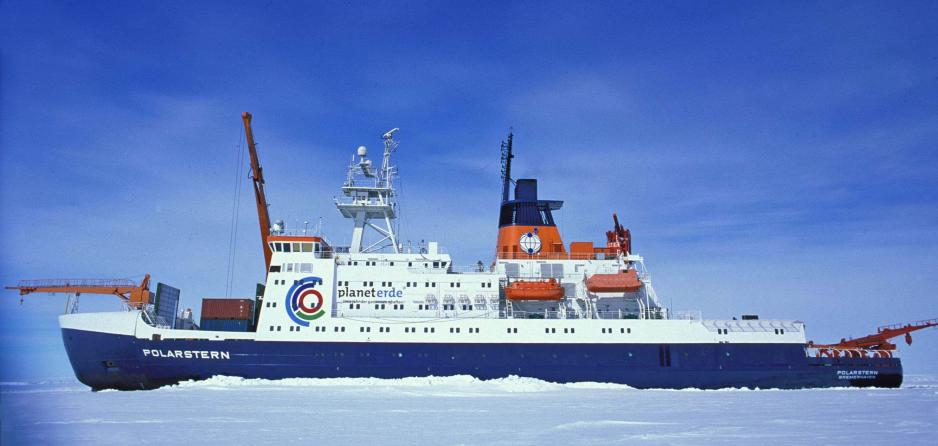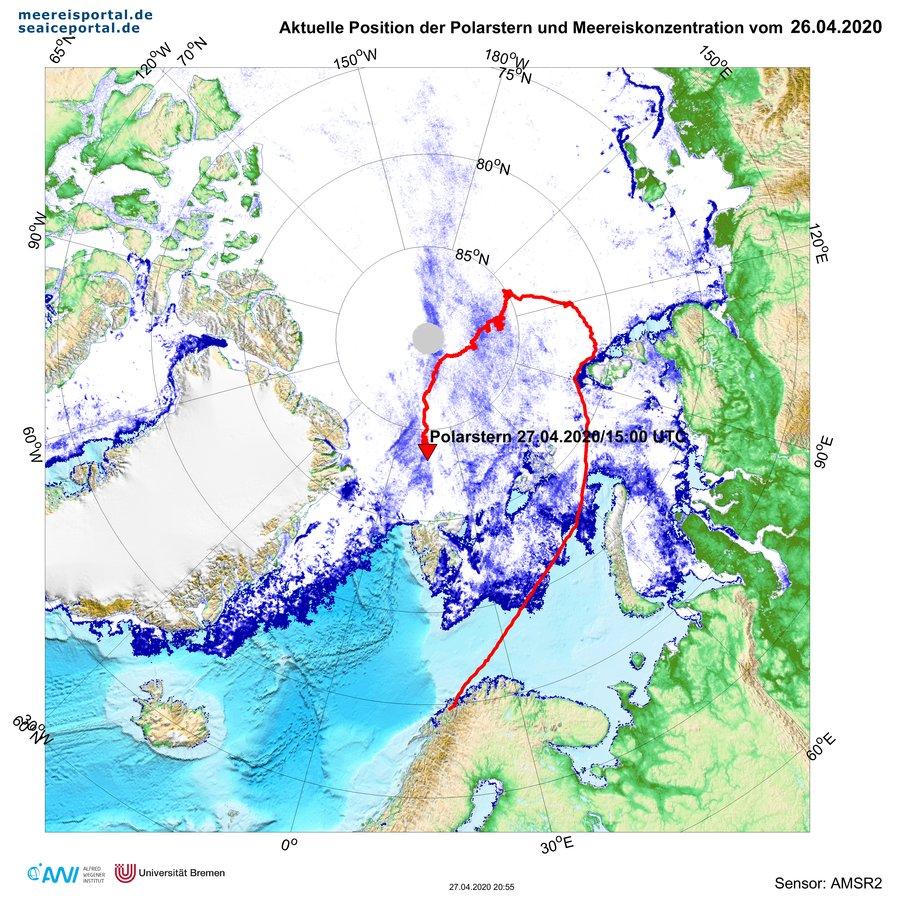Arctic MOSAiC Expedition Overcomes Logistical Challenges from Covid-19

Polar research vessel Polarstern surrounded by ice. (Photo: Courtesy of Hannes Grobe/AWI)
With aerial and icebreaker resupply missions scrapped, the Polarstern icebreaker will leave the ice camp and rendezvous with two German research vessels to transfer staff and provisions.
Project leaders of the year-long MOSAiC science expedition presented an innovative solution to overcoming the logistical challenges arising from ongoing travel bans in light of the Corona pandemic. Rather than having supply ships come to it, the Polarstern will exit from the ice and meet two research vessels off the coast of Svalbard to exchange 100 staff and restock provisions.
The ship has been drifting across the Arctic Ocean enclosed by sea ice since last Fall. Originally the project organizers had planned to conduct five crew exchanges and resupply missions over the course of the 13 month project.
While the first two crew exchanges at the end of 2019 and in late February happened as planned, an aerial transfer of staff and resupply out of Svalbard had to be canceled as Norwegian authorities have placed the archipelago on lockdown due to the pandemic.
No icebreakers available
In early April project leaders had considered chartering an icebreaker or moving a planned resupply mission of the icebreaker Odin from mid-June to mid-May. However, none of these options turned out to be feasible in light of the travel restrictions.
“The current situation also means [that] the international icebreakers that were originally meant to resupply the expedition are also prohibited from making any staff transfers,” explain officials from the Alfred-Wegener-Institute (AWI), the lead German government-funded research organization behind the expedition. “The massive restrictions on global travel hindered the third team exchange, which had been planned as an aerial transfer in early April, using the Spitsbergen archipelago as a base of operations.”
The organizers now intend to bring the Polarstern out of the ice and rendezvous with two German research vessels, RV Sonne and RV Maria S. Merian, in calm waters off Svalbard to conduct a full swap of around 100 staff and researchers and provide a full resupply. Afterwards the Polarstern will return to the ice and continue its scientific work. Both RV Sonne and RV Maria S. Merian are currently docked in the north German port of Emden after having returned from South Africa and Uruguay respectively.

RV Sonne and RV Maria S. Merian (Photos: Courtesy of Roman Kroke/UFZ and Universität Hamburg/LDF/K. v. Bröckel)
Close to Svalbard already
Fortunately the drift corridor of the Polarstern has already taken the vessel in the direction of Svalbard and it is currently located between the North Pole and Fram Strait. “For the upcoming logistical operation, this position is advantageous. Some instruments on the MOSAiC ice floe will continue recording autonomously until Polarstern returns, while others will be dismantled,” explains the AWI.
The project leaders may also use the Polarstern’s departure from the ice as an opportunity to relocate the ice camp closer to the North Pole. This possibility has always been part of the planning scenarios in case the ship drifted faster than anticipated and will not have an impact on the scientific research being conducted. “If we drift too far south, we will set up the Ice Camp again farther north, and continue our observations in a region where the Central Arctic is still covered with ice in the summer. We’re thrilled with the tremendous amount of data we’ve been able to gather over the past seven months,” states expedition leader Prof Markus Rex from the AWI.
“With this alternative plan, the AWI’s Logistics Team, together with our international partners, achieved a true masterstroke in the face of the enormous challenges posed by the coronavirus crisis,” continues Rex. “The pandemic forced us to devise a complex alternative scenario for wholly new, unforeseen and unprecedented circumstances.”
With this unconventional solution the continuation of the expedition has been secured according to the AWI.

Location of the Polarstern on April 27, to the North of Svalbard. (Graphic: Courtesy of AWI)
Quarantine and testing for all staff
In order to ensure the safety of all participants and keep Covid-19 off the Polarstern the relief crew and researchers heading to the Arctic will be undergoing a monitored quarantine phase starting in early May.
This change of plans also means that there will only be four crew exchange and resupply missions as compared to the five originally planned. No details have yet been given on when and how the fourth and final transfer will be conducted. Originally, the last two exchanges were supposed to happen in mid-June and mid-August using the Swedish icebreaker Oden and the Chinese icebreaker Xue Long. The mission, which costs an estimated 130m Euro, is expected to end as planned in mid-October.

